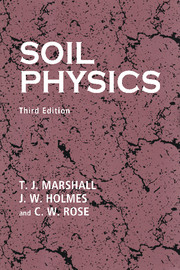Book contents
- Frontmatter
- Contents
- Preface
- Preface to the second edition
- Preface to the first edition
- 1 Composition of soil
- 2 Interaction of soil and water
- 3 Measurement of water content and potential
- 4 Principles of water movement in soil
- 5 Distribution of water in soil
- 6 Ground water in soils and aquifers
- 7 The use of isotopes and other tracers in soil water and groundwater studies
- 8 Soil structure
- 9 Deformation of soil
- 10 Management of soil water
- 11 Soil erosion and conservation
- 12 Chemical transport in soil
- 13 The physical environment of roots
- 14 Plants and soil water
- Appendixes
- References
- Index
11 - Soil erosion and conservation
Published online by Cambridge University Press: 05 June 2012
- Frontmatter
- Contents
- Preface
- Preface to the second edition
- Preface to the first edition
- 1 Composition of soil
- 2 Interaction of soil and water
- 3 Measurement of water content and potential
- 4 Principles of water movement in soil
- 5 Distribution of water in soil
- 6 Ground water in soils and aquifers
- 7 The use of isotopes and other tracers in soil water and groundwater studies
- 8 Soil structure
- 9 Deformation of soil
- 10 Management of soil water
- 11 Soil erosion and conservation
- 12 Chemical transport in soil
- 13 The physical environment of roots
- 14 Plants and soil water
- Appendixes
- References
- Index
Summary
Issues involved in soil erosion
The erosion of soil and rock by water, wind, and ice is a natural process, commonly accelerated by human activity. Geological erosion over long periods of time has provided the parent material from which soil can be built. Such erosion by water and the subsequent deposition in flood plains is the origin of productive alluvial soils, but if natural processes are extreme or very rapid, as in large-scale landslides, these can cause human tragedy.
Human activity has greatly accelerated the rate of natural erosion. Expanding populations and their demand for land-based resources has led to rapid conversion of forest and grassland to rural, urban, industrial, and other uses. Such change commonly removes the protective land cover under which soils slowly develop their pedological and biological characteristics. The degree of hazard induced by such change varies a great deal with climate and topographic factors, and with the type of soil material exposed. Inappropriate methods of forestry/land clearing or agricultural land management, or overgrazing of pasture or savannah lands can lead to accelerated rates of soil erosion, which can threaten or undermine the sustainability of such land use (Riquier, 1982). About 50 years ago, serious erosion of farmland in North America, Africa, and Australia, for example, was apparent through the development of large gullies, or dust storms of increasing frequency and intensity. Examples of the history of this recognition are given by Bennett (1939).
- Type
- Chapter
- Information
- Soil Physics , pp. 274 - 320Publisher: Cambridge University PressPrint publication year: 1996



